The Cambridge History of Japan, Vol. 4: Early Modern Japan
Подождите немного. Документ загружается.

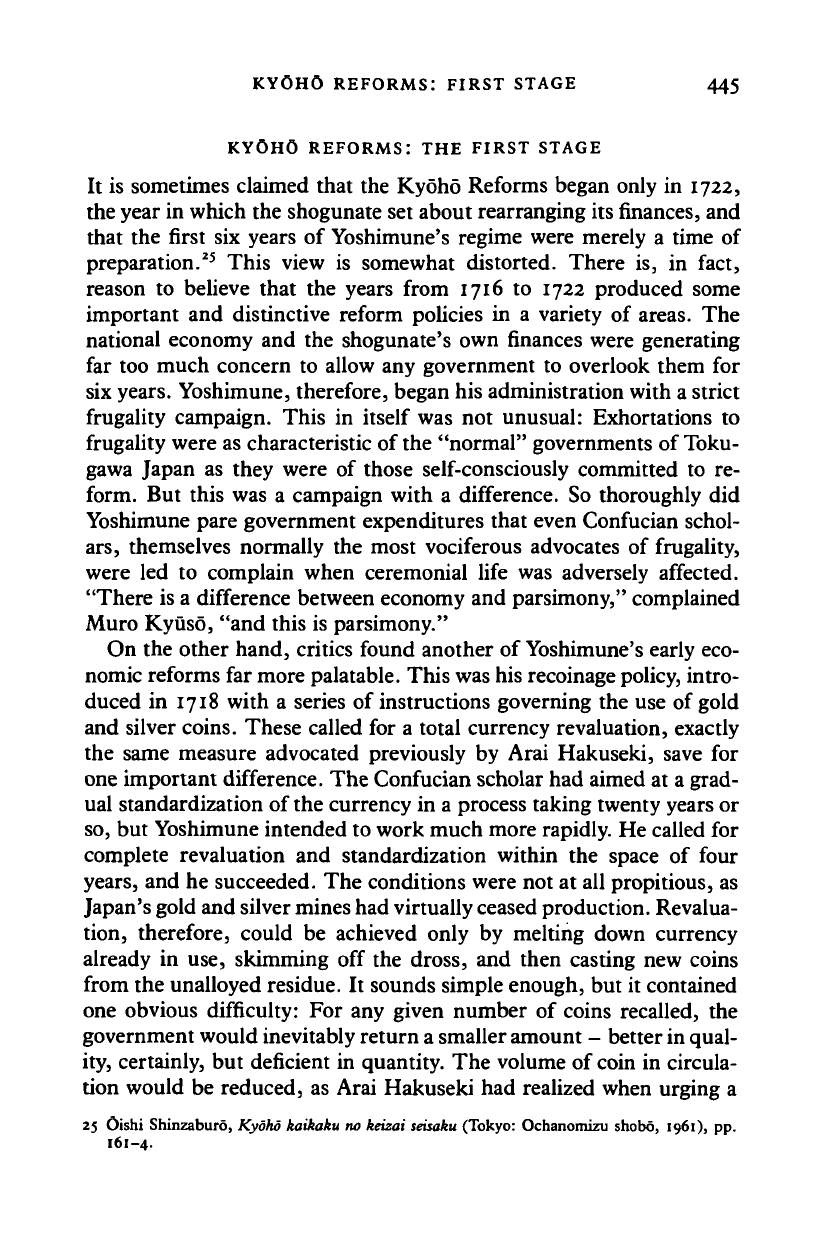
KYOHO REFORMS: FIRST STAGE 445
KYOHO REFORMS: THE FIRST STAGE
It is sometimes claimed that the Kyoho Reforms began only in 1722,
the year in which the shogunate set about rearranging its finances, and
that the first six years of Yoshimune's regime were merely a time of
preparation.
25
This view is somewhat distorted. There is, in fact,
reason to believe that the years from 1716 to 1722 produced some
important and distinctive reform policies in a variety of areas. The
national economy and the shogunate's own finances were generating
far too much concern to allow any government to overlook them for
six years. Yoshimune, therefore, began his administration with a strict
frugality campaign. This in itself was not unusual: Exhortations to
frugality were as characteristic of the "normal" governments of Toku-
gawa Japan as they were of those self-consciously committed to re-
form. But this was a campaign with a difference. So thoroughly did
Yoshimune pare government expenditures that even Confucian schol-
ars,
themselves normally the most vociferous advocates of frugality,
were led to complain when ceremonial life was adversely affected.
"There is a difference between economy and parsimony," complained
Muro Kyuso, "and this is parsimony."
On the other hand, critics found another of Yoshimune's early eco-
nomic reforms far more palatable. This was his recoinage policy, intro-
duced in 1718 with a series of instructions governing the use of gold
and silver coins. These called for a total currency revaluation, exactly
the same measure advocated previously by Arai Hakuseki, save for
one important difference. The Confucian scholar had aimed at a grad-
ual standardization of the currency in a process taking twenty years or
so,
but Yoshimune intended to work much more rapidly. He called for
complete revaluation and standardization within the space of four
years,
and he succeeded. The conditions were not at all propitious, as
Japan's gold and silver mines had virtually ceased production. Revalua-
tion, therefore, could be achieved only by melting down currency
already in use, skimming off the dross, and then casting new coins
from the unalloyed residue. It sounds simple enough, but it contained
one obvious difficulty: For any given number of coins recalled, the
government would inevitably return
a
smaller amount - better in qual-
ity, certainly, but deficient in quantity. The volume of coin in circula-
tion would be reduced, as Arai Hakuseki had realized when urging a
25 Oishi Shinzaburo, Kyoho kaihaku no keizai seisaku (Tokyo: Ochanomizu shobo, 1961), pp.
161-4.
Cambridge Histories Online © Cambridge University Press, 2008
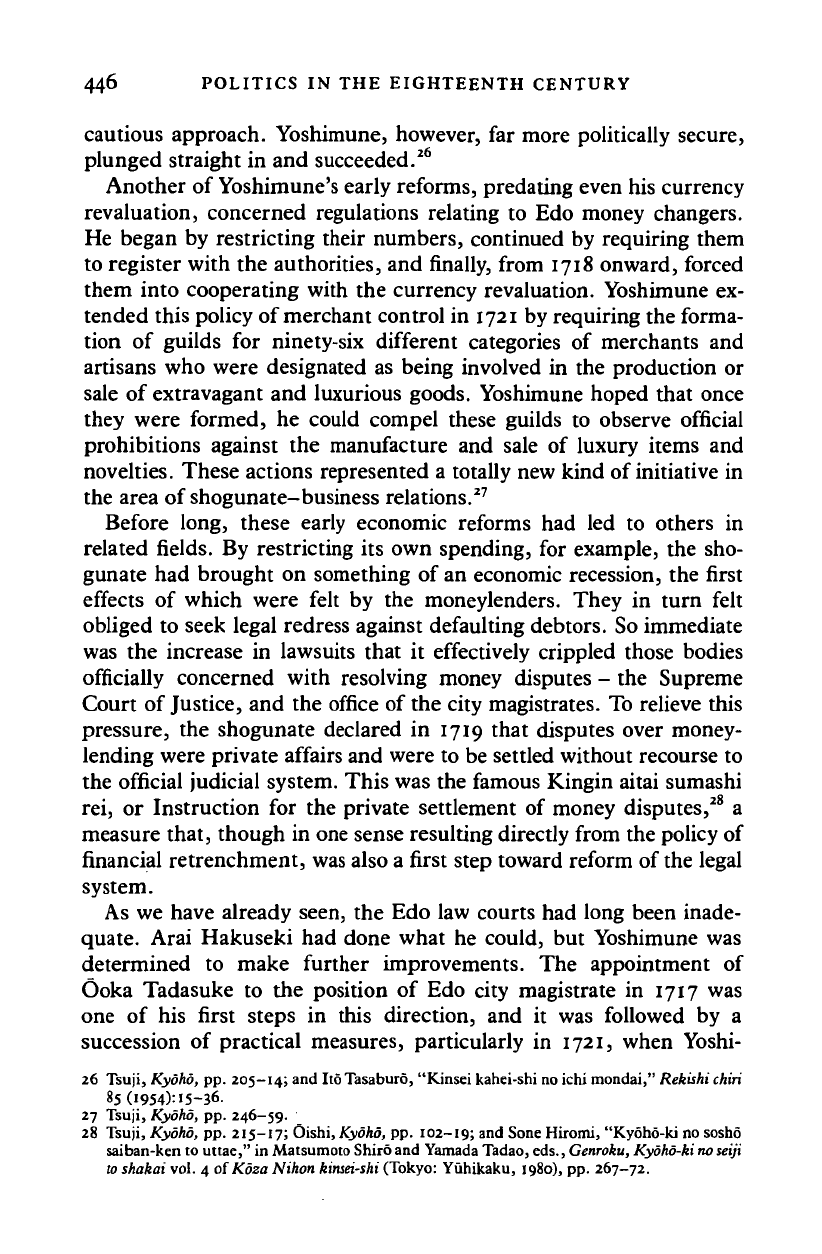
446 POLITICS IN THE EIGHTEENTH CENTURY
cautious approach. Yoshimune, however, far more politically secure,
plunged straight in and succeeded.
26
Another of Yoshimune's early reforms, predating even his currency
revaluation, concerned regulations relating to Edo money changers.
He began by restricting their numbers, continued by requiring them
to register with the authorities, and finally, from 1718 onward, forced
them into cooperating with the currency revaluation. Yoshimune ex-
tended this policy of merchant control in 1721 by requiring the forma-
tion of guilds for ninety-six different categories of merchants and
artisans who were designated as being involved in the production or
sale of extravagant and luxurious goods. Yoshimune hoped that once
they were formed, he could compel these guilds to observe official
prohibitions against the manufacture and sale of luxury items and
novelties. These actions represented a totally new kind of initiative in
the area of shogunate-business relations.
27
Before long, these early economic reforms had led to others in
related fields. By restricting its own spending, for example, the sho-
gunate had brought on something of an economic recession, the first
effects of which were felt by the moneylenders. They in turn felt
obliged to seek legal redress against defaulting debtors. So immediate
was the increase in lawsuits that it effectively crippled those bodies
officially concerned with resolving money disputes - the Supreme
Court of Justice, and the office of the city magistrates. To relieve this
pressure, the shogunate declared in 1719 that disputes over money-
lending were private affairs and were to be settled without recourse to
the official judicial system. This was the famous Kingin aitai sumashi
rei,
or Instruction for the private settlement of money disputes,
28
a
measure that, though in one sense resulting directly from the policy of
financial retrenchment, was also a first step toward reform of the legal
system.
As we have already seen, the Edo law courts had long been inade-
quate. Arai Hakuseki had done what he could, but Yoshimune was
determined to make further improvements. The appointment of
Ooka Tadasuke to the position of Edo city magistrate in 1717 was
one of his first steps in this direction, and it was followed by a
succession of practical measures, particularly in 1721, when Yoshi-
26 Tsuji,
Kyoho,
pp. 205-14; and Ito Tasaburd, "Kinsei kahei-shi no ichi mondai,"
Rekishi chiri
85 (1954):I5-36-
27 Tsuji,
Kyoho,
pp. 246-59.
28 Tsuji,
Kyoho,
pp. 215-17; Oishi,
Kyoho,
pp. 102-19; and Sone Hiromi, "Kyoho-ki no sosho
saiban-ken to uttae," in Matsumoto Shiro and Yamada Tadao, eds.,
Genroku,
Kyoho-ki no seiji
to shakai
vol. 4 of Koza Nihon
kinsei-shi
(Tokyo: Yuhikaku, 1980), pp. 267-72.
Cambridge Histories Online © Cambridge University Press, 2008

KYOHO REFORMS: FIRST STAGE 447
mune held a special session in Edo Castle so that he might see how
his magistrates operated.
The main object of this legal reform was to speed up the legal
process. To this end there was an attempt to simplify the presentation
and hearing of petitions, but it is also noteworthy that efforts were
made to have disputes settled informally at a lower level, by the
mediation of such figures as ward headmen, before they could be-
come a formal lawsuits - exactly the principle applied to disputes
concerning money.
29
Further, at the beginning of 1720 the shogun
ordered those involved in the Supreme Court of Justice - the superin-
tendents of temples and shrines, the Edo city magistrates, and the
superintendents of finance - to collect and make public those regula-
tions concerning the prompt reporting of grievances and the proper
form for contracts, in the hope that this might reduce the volume of
lawsuits.
30
This was by no means all, for at the same time officials were to
designate which punishments were appropriate to which crimes, the
first time in Tokugawa history that an attempt was made to establish
and publicize a set of judicial procedures. Clearly, this was an attempt
to create an impartial legal system. Precedents and legal instructions
themselves were codified in 1724 under the title Kyohodo horitsu
ruiyose (A collection of laws of the Kyoho period), although it is not
clear to what extent they were actually used. Also, in the interests of
an impartial legal system, restrictions were imposed in 1722 on the use
of torture, the object being to save people from being vigorously per-
suaded into confessing to crimes they had not committed. The sugges-
tion box also played a part here, as it provided a safe way of complain-
ing about dishonest or biased judgments.
31
A third strand in Yoshimune's legal reforms concerned the ameliora-
tion of punishment. In 1721 it was decreed that families of those
common people found guilty of serious crimes were to be spared the
automatic charge of complicity that otherwise would have followed.
This was no more than sensible in a society in which single men were
moving from the country to towns and cities, leaving friends and
family behind. Limits were also placed on terms of banishment, and
instructions were given that such sentences be commuted to fines; this
too seemed more appropriate now that unification under the Toku-
gawa government had robbed banishment of much of its significance.
29 Sone, Kyoho, pp. 275-9. 30 Tsuji, Ooka, pp. 125-7.
31 Tsuji, Ooka, pp. 145-50, 133-5; Tsuji, Kyoho, pp. 119-26; Sone, "Kyoho," pp. 279-90.
Cambridge Histories Online © Cambridge University Press, 2008
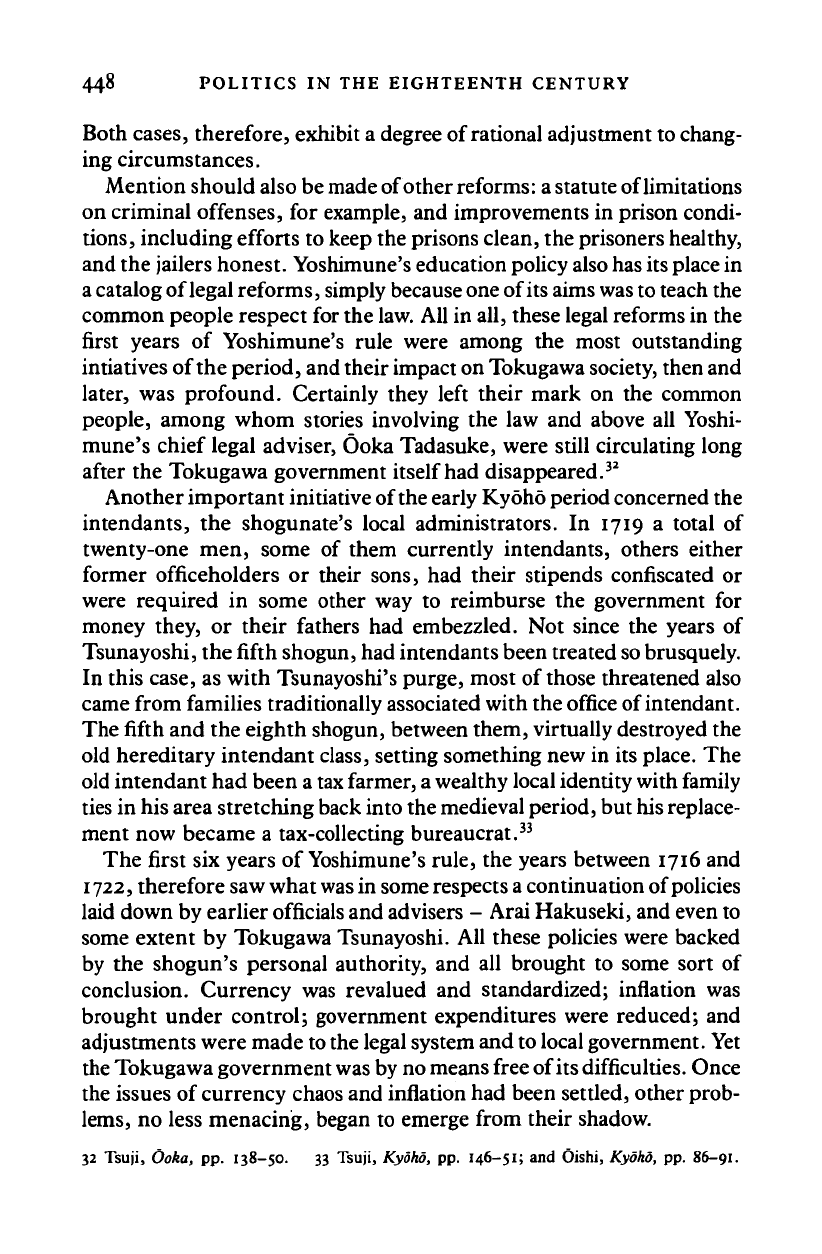
448 POLITICS IN THE EIGHTEENTH CENTURY
Both cases, therefore, exhibit a degree of rational adjustment to chang-
ing circumstances.
Mention should also be made of other reforms:
a
statute of limitations
on criminal offenses, for example, and improvements in prison condi-
tions,
including efforts to keep the prisons clean, the prisoners healthy,
and the jailers honest. Yoshimune's education policy
also has its place
in
a catalog of legal reforms, simply because
one
of its
aims was to
teach the
common people respect for the
law.
All in all, these legal reforms in the
first years of Yoshimune's rule were among the most outstanding
intiatives of the period, and their impact on Tokugawa society, then and
later, was profound. Certainly they left their mark on the common
people, among whom stories involving the law and above all Yoshi-
mune's chief legal adviser, Ooka Tadasuke, were still circulating long
after the Tokugawa government itself had disappeared.
32
Another important initiative of the early Kyoho period concerned the
intendants, the shogunate's local administrators. In 1719 a total of
twenty-one men, some of them currently intendants, others either
former officeholders or their sons, had their stipends confiscated or
were required in some other way to reimburse the government for
money they, or their fathers had embezzled. Not since the years of
Tsunayoshi, the fifth shogun, had intendants been treated
so
brusquely.
In this case, as with Tsunayoshi's purge, most of those threatened also
came from families traditionally associated with the office of intendant.
The fifth and the eighth shogun, between them, virtually destroyed the
old hereditary intendant class, setting something new in its place. The
old intendant had been
a tax
farmer,
a
wealthy local identity with family
ties in his area stretching back into the medieval period, but
his
replace-
ment now became a tax-collecting bureaucrat.
33
The first six years of Yoshimune's rule, the years between 1716 and
1722,
therefore saw what
was
in some respects
a
continuation of policies
laid down by earlier officials and advisers - Arai Hakuseki, and even to
some extent by Tokugawa Tsunayoshi. All these policies were backed
by the shogun's personal authority, and all brought to some sort of
conclusion. Currency was revalued and standardized; inflation was
brought under control; government expenditures were reduced; and
adjustments were made
to
the legal system and
to
local government. Yet
the Tokugawa government
was
by no means free of its difficulties. Once
the issues of currency chaos and inflation had been settled, other prob-
lems,
no less menacing, began to emerge from their shadow.
32 Tsuji, Ooka, pp. 138-50. 33 Tsuji, Kyoho, pp. 146-51; and Oishi, Kyoho, pp.
86-91.
Cambridge Histories Online © Cambridge University Press, 2008
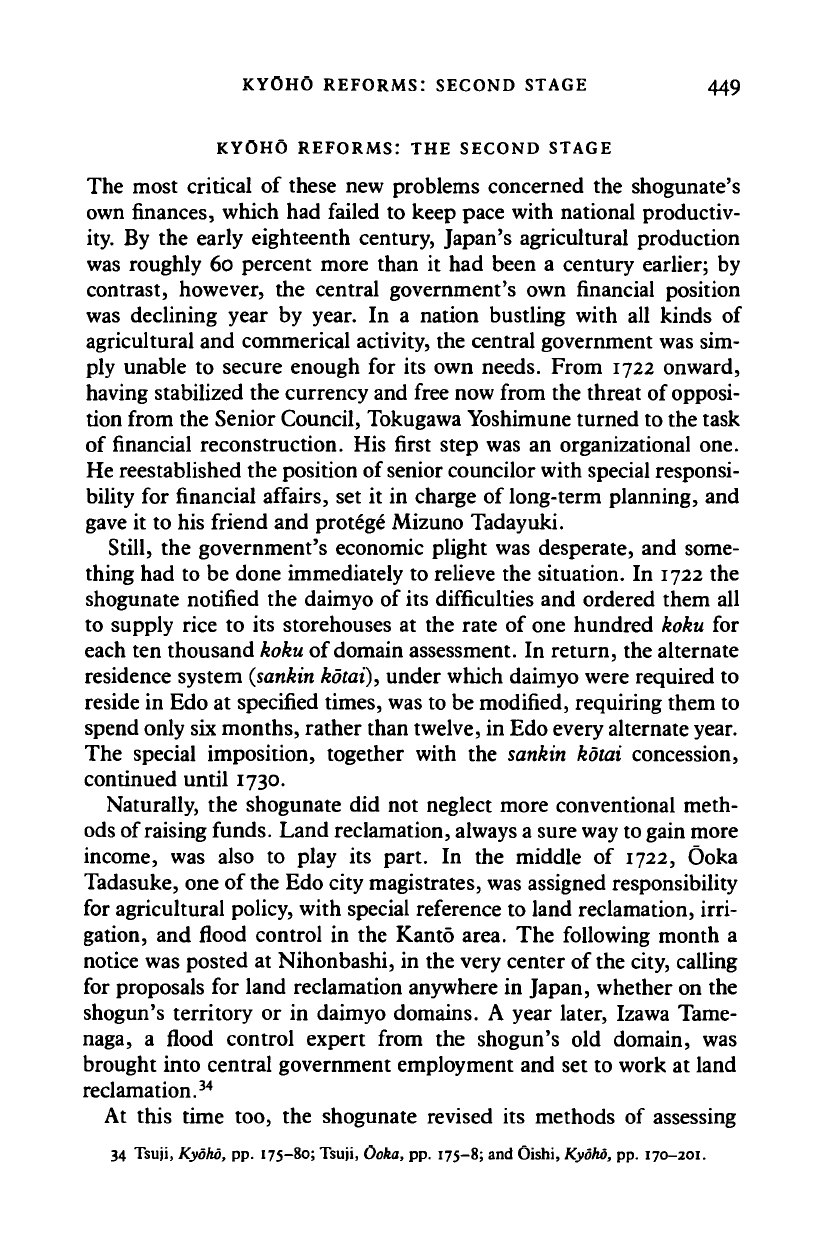
KYOHO
REFORMS:
SECOND STAGE 449
KYOHO
REFORMS:
THE SECOND STAGE
The most critical of these new problems concerned the shogunate's
own finances, which had failed to keep pace with national productiv-
ity. By the early eighteenth century, Japan's agricultural production
was roughly 60 percent more than it had been a century earlier; by
contrast, however, the central government's own financial position
was declining year by year. In a nation bustling with all kinds of
agricultural and commerical activity, the central government was sim-
ply unable to secure enough for its own needs. From 1722 onward,
having stabilized the currency and free now from the threat of opposi-
tion from the Senior Council, Tokugawa Yoshimune turned to the task
of financial reconstruction. His first step was an organizational one.
He reestablished the position of senior councilor with special responsi-
bility for financial affairs, set it in charge of long-term planning, and
gave it to his friend and protege Mizuno Tadayuki.
Still,
the government's economic plight was desperate, and some-
thing had to be done immediately to relieve the situation. In 1722 the
shogunate notified the daimyo of its difficulties and ordered them all
to supply rice to its storehouses at the rate of one hundred koku for
each ten thousand koku of domain assessment. In return, the alternate
residence system
(sankin
kotai),
under which daimyo were required to
reside in Edo at specified times, was to be modified, requiring them to
spend only six months, rather than twelve, in Edo every alternate year.
The special imposition, together with the sankin kotai concession,
continued until 1730.
Naturally, the shogunate did not neglect more conventional meth-
ods of raising funds. Land reclamation, always a sure way to gain more
income, was also to play its part. In the middle of 1722, Ooka
Tadasuke, one of the Edo city magistrates, was assigned responsibility
for agricultural policy, with special reference to land reclamation, irri-
gation, and flood control in the Kanto area. The following month a
notice was posted at Nihonbashi, in the very center of the city, calling
for proposals for land reclamation anywhere in Japan, whether on the
shogun's territory or in daimyo domains. A year later, Izawa Tame-
naga, a flood control expert from the shogun's old domain, was
brought into central government employment and set to work at land
reclamation.
34
At this time too, the shogunate revised its methods of assessing
34
Tsuji, Kyoho, pp. 175-80; Tsuji, Ooka, pp.
175-8;
and Oishi, Kyoho, pp.
170-201.
Cambridge Histories Online © Cambridge University Press, 2008
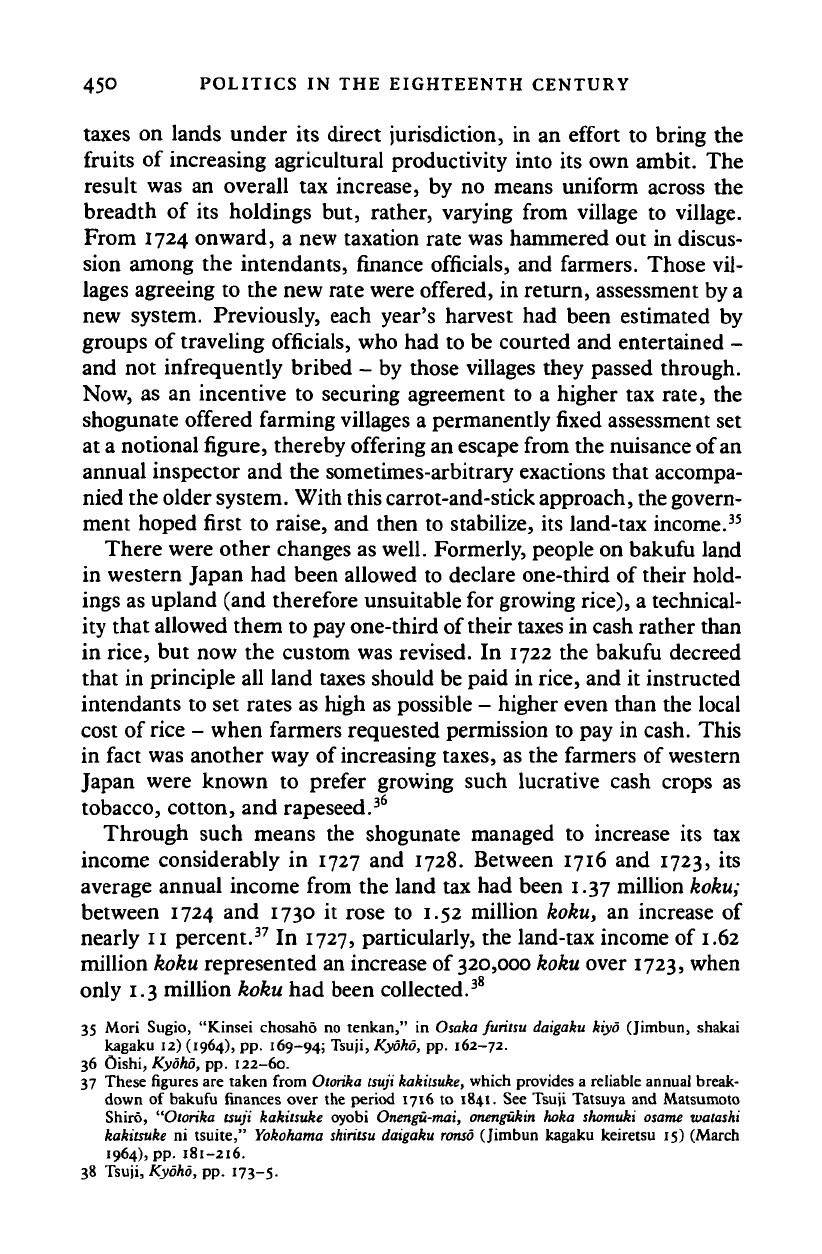
45O POLITICS IN THE EIGHTEENTH CENTURY
taxes on lands under its direct jurisdiction, in an effort to bring the
fruits of increasing agricultural productivity into its own ambit. The
result was an overall tax increase, by no means uniform across the
breadth of its holdings but, rather, varying from village to village.
From 1724 onward, a new taxation rate was hammered out in discus-
sion among the intendants, finance officials, and farmers. Those vil-
lages agreeing to the new rate were offered, in return, assessment by a
new system. Previously, each year's harvest had been estimated by
groups of traveling officials, who had to be courted and entertained -
and not infrequently bribed - by those villages they passed through.
Now, as an incentive to securing agreement to a higher tax rate, the
shogunate offered farming villages a permanently fixed assessment set
at a notional figure, thereby offering an escape from the nuisance of an
annual inspector and the sometimes-arbitrary exactions that accompa-
nied the older system. With this carrot-and-stick approach, the govern-
ment hoped first to raise, and then to stabilize, its land-tax income.
35
There were other changes as well. Formerly, people on bakufu land
in western Japan had been allowed to declare one-third of their hold-
ings as upland (and therefore unsuitable for growing rice), a technical-
ity that allowed them to pay one-third of their taxes in cash rather than
in rice, but now the custom was revised. In 1722 the bakufu decreed
that in principle all land taxes should be paid in rice, and it instructed
intendants to set rates as high as possible - higher even than the local
cost of rice - when farmers requested permission to pay in cash. This
in fact was another way of increasing taxes, as the farmers of western
Japan were known to prefer growing such lucrative cash crops as
tobacco, cotton, and rapeseed.
36
Through such means the shogunate managed to increase its tax
income considerably in 1727 and 1728. Between 1716 and 1723, its
average annual income from the land tax had been 1.37 million koku;
between 1724 and 1730 it rose to 1.52 million koku, an increase of
nearly 11 percent.
37
In 1727, particularly, the land-tax income of 1.62
million koku represented an increase of 320,000 koku over 1723, when
only 1.3 million koku had been collected.
38
35 Mori Sugio, "Kinsei chosaho no tenkan," in Osaka furilsu daigaku kiyo (Jimbun, shakai
kagaku 12) (1964), pp. 169-94; Tsuji, Kyoho, pp. 162-72.
36 Oishi, Kyoho, pp. 122-60.
37 These figures are taken from Otorika tsuji kakitsuke, which provides a reliable annual break-
down of bakufu finances over the period 1716 to 1841. See Tsuji Tatsuya and Matsumoto
Shiro,
"Otorika tsuji kakitsuke oyobi Onengu-mai, onengukin hoka shomuki osame watashi
kakitsuke ni tsuite," Yokohama shiritsu daigaku
ronso
(Jimbun kagaku keiretsu 15) (March
1964),
pp. 181-216.
38 Tsuji, Kyoho, pp. 173-5-
Cambridge Histories Online © Cambridge University Press, 2008
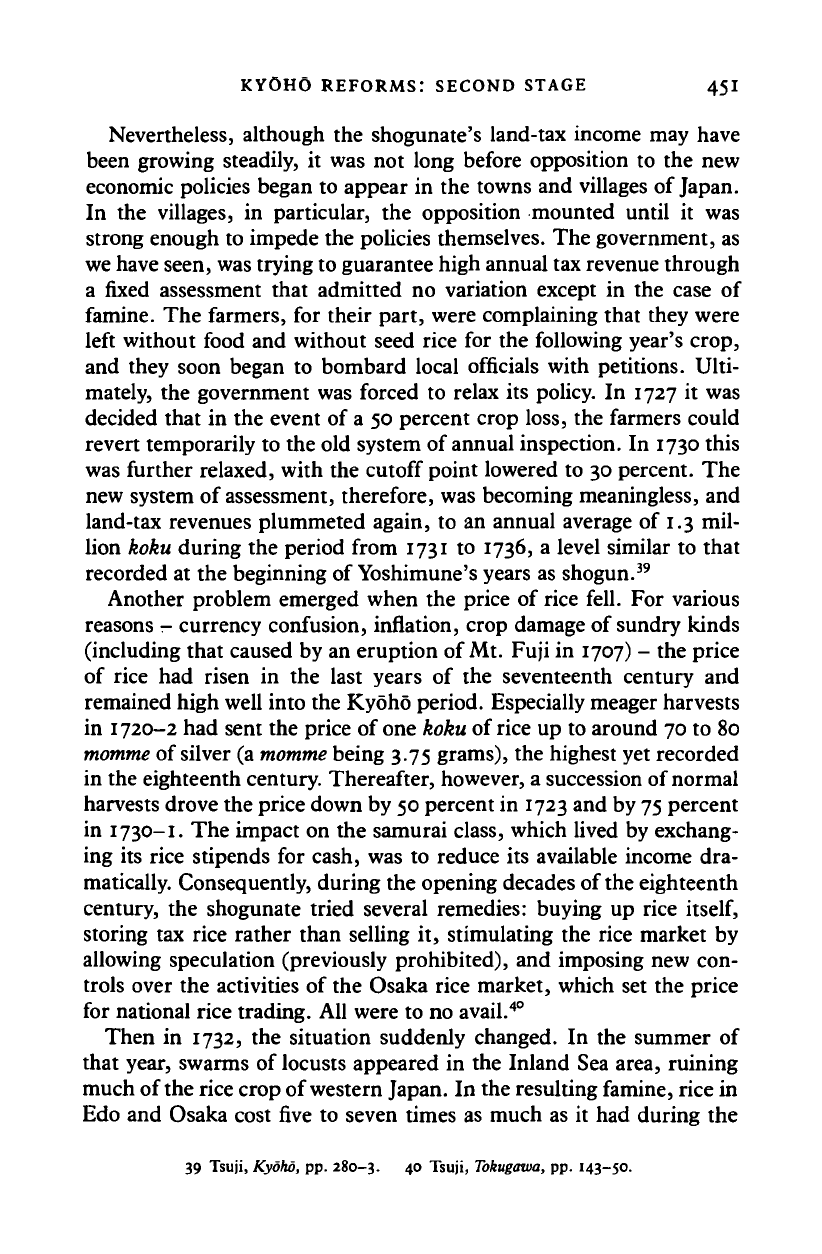
KYOHO
REFORMS:
SECOND STAGE 451
Nevertheless, although the shogunate's land-tax income may have
been growing steadily, it was not long before opposition to the new
economic policies began to appear in the towns and villages of Japan.
In the villages, in particular, the opposition mounted until it was
strong enough to impede the policies themselves. The government, as
we have seen, was trying to guarantee high annual tax revenue through
a fixed assessment that admitted no variation except in the case of
famine.
The farmers, for their part, were complaining that they were
left without food and without seed rice for the following year's crop,
and they soon began to bombard local officials with petitions. Ulti-
mately, the government was forced to relax its policy. In 1727 it was
decided that in the event of a 50 percent crop loss, the farmers could
revert temporarily to the old system of annual inspection. In 1730 this
was further relaxed, with the cutoff point lowered to 30 percent. The
new system of assessment, therefore, was becoming meaningless, and
land-tax revenues plummeted again, to an annual average of 1.3 mil-
lion koku during the period from 1731 to 1736, a level similar to that
recorded at the beginning of Yoshimune's years as shogun.
39
Another problem emerged when the price of rice fell. For various
reasons - currency confusion, inflation, crop damage of sundry kinds
(including that caused by an eruption of Mt. Fuji in 1707) - the price
of rice had risen in the last years of the seventeenth century and
remained high well into the Kyoho period. Especially meager harvests
in 1720-2 had sent the price of one koku of rice up to around 70 to 80
momme
of silver (a
momme
being 3.75 grams), the highest yet recorded
in the eighteenth century. Thereafter, however, a succession of normal
harvests drove the price down by 50 percent in
1723
and by
75
percent
in
1730-1.
The impact on the samurai class, which lived by exchang-
ing its rice stipends for cash, was to reduce its available income dra-
matically. Consequently, during the opening decades of
the
eighteenth
century, the shogunate tried several remedies: buying up rice
itself,
storing tax rice rather than selling it, stimulating the rice market by
allowing speculation (previously prohibited), and imposing new con-
trols over the activities of the Osaka rice market, which set the price
for national rice trading. All were to no avail.
40
Then in 1732, the situation suddenly changed. In the summer of
that year, swarms of locusts appeared in the Inland Sea area, ruining
much of the rice crop of western Japan. In the resulting famine, rice in
Edo and Osaka cost five to seven times as much as it had during the
39
Tsuji, Kyoho, pp.
280-3.
4° Tsuji,
Tokugawa,
pp. 143-50.
Cambridge Histories Online © Cambridge University Press, 2008
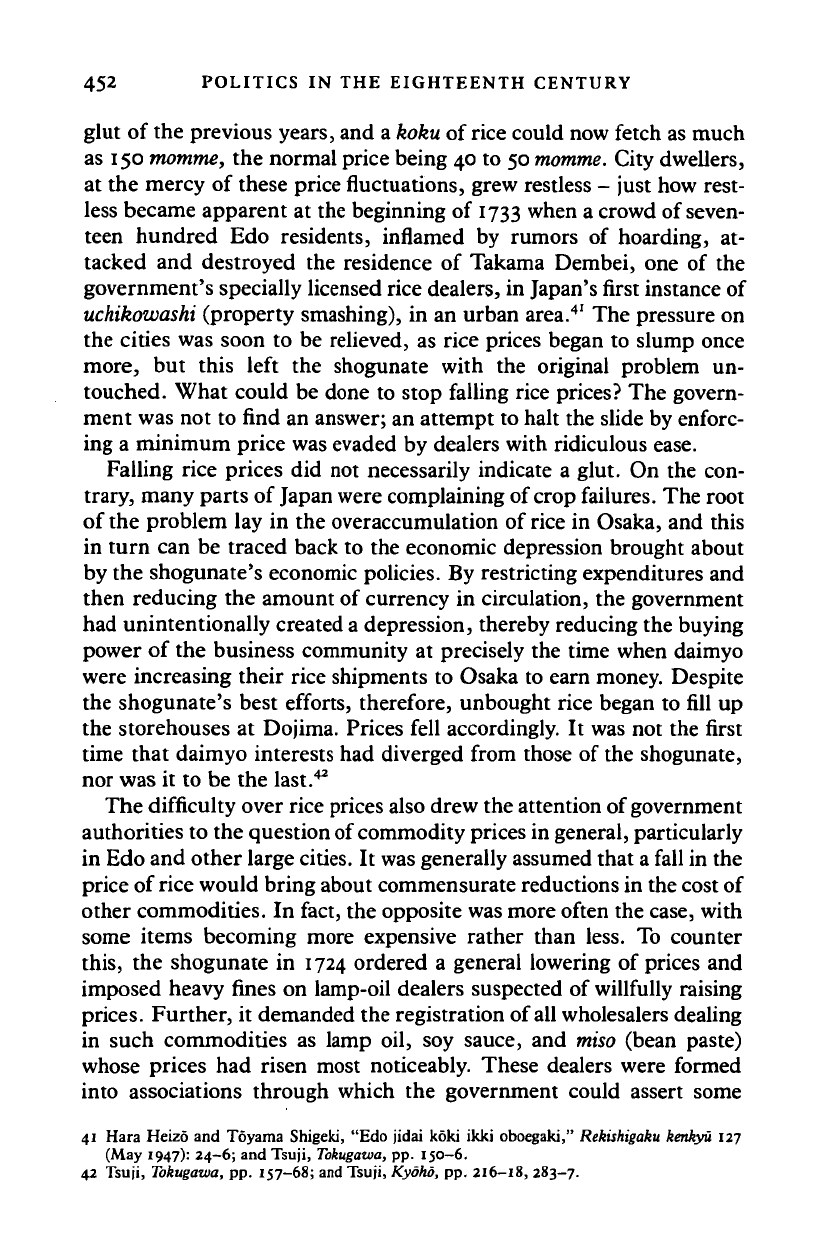
452 POLITICS IN THE EIGHTEENTH CENTURY
glut of the previous years, and a koku of
rice
could now fetch as much
as 150
momme,
the normal price being 40 to 50
momme.
City dwellers,
at the mercy of these price fluctuations, grew restless - just how rest-
less became apparent at the beginning of 1733 when a crowd of seven-
teen hundred Edo residents, inflamed by rumors of hoarding, at-
tacked and destroyed the residence of Takama Dembei, one of the
government's specially licensed rice dealers, in Japan's first instance of
uchikowashi
(property smashing), in an urban area.
41
The pressure on
the cities was soon to be relieved, as rice prices began to slump once
more, but this left the shogunate with the original problem un-
touched. What could be done to stop falling rice prices? The govern-
ment was not to find an answer; an attempt to halt the slide by enforc-
ing a minimum price was evaded by dealers with ridiculous ease.
Falling rice prices did not necessarily indicate a glut. On the con-
trary, many parts of Japan were complaining of
crop
failures. The root
of the problem lay in the overaccumulation of rice in Osaka, and this
in turn can be traced back to the economic depression brought about
by the shogunate's economic policies. By restricting expenditures and
then reducing the amount of currency in circulation, the government
had unintentionally created a depression, thereby reducing the buying
power of the business community at precisely the time when daimyo
were increasing their rice shipments to Osaka to earn money. Despite
the shogunate's best efforts, therefore, unbought rice began to fill up
the storehouses at Dojima. Prices fell accordingly. It was not the first
time that daimyo interests had diverged from those of the shogunate,
nor was it to be the last.
42
The difficulty over rice prices also drew the attention of government
authorities to the question of commodity prices in general, particularly
in Edo and other large cities. It was generally assumed that a fall in the
price of
rice
would bring about commensurate reductions in the cost of
other commodities. In fact, the opposite was more often the case, with
some items becoming more expensive rather than less. To counter
this,
the shogunate in 1724 ordered a general lowering of prices and
imposed heavy fines on lamp-oil dealers suspected of willfully raising
prices. Further, it demanded the registration of
all
wholesalers dealing
in such commodities as lamp oil, soy sauce, and
miso
(bean paste)
whose prices had risen most noticeably. These dealers were formed
into associations through which the government could assert some
41 Hara Heizo and Toyama Shigeki, "Edo jidai koki ikki oboegaki," Rekishigaku kenkyu 127
(May 1947): 24-6; and Tsuji,
Tokugawa,
pp. 150-6.
42 Tsuji, Tokugawa, pp. 157-68; and Tsuji, Kyoho, pp. 216-18, 283-7.
Cambridge Histories Online © Cambridge University Press, 2008
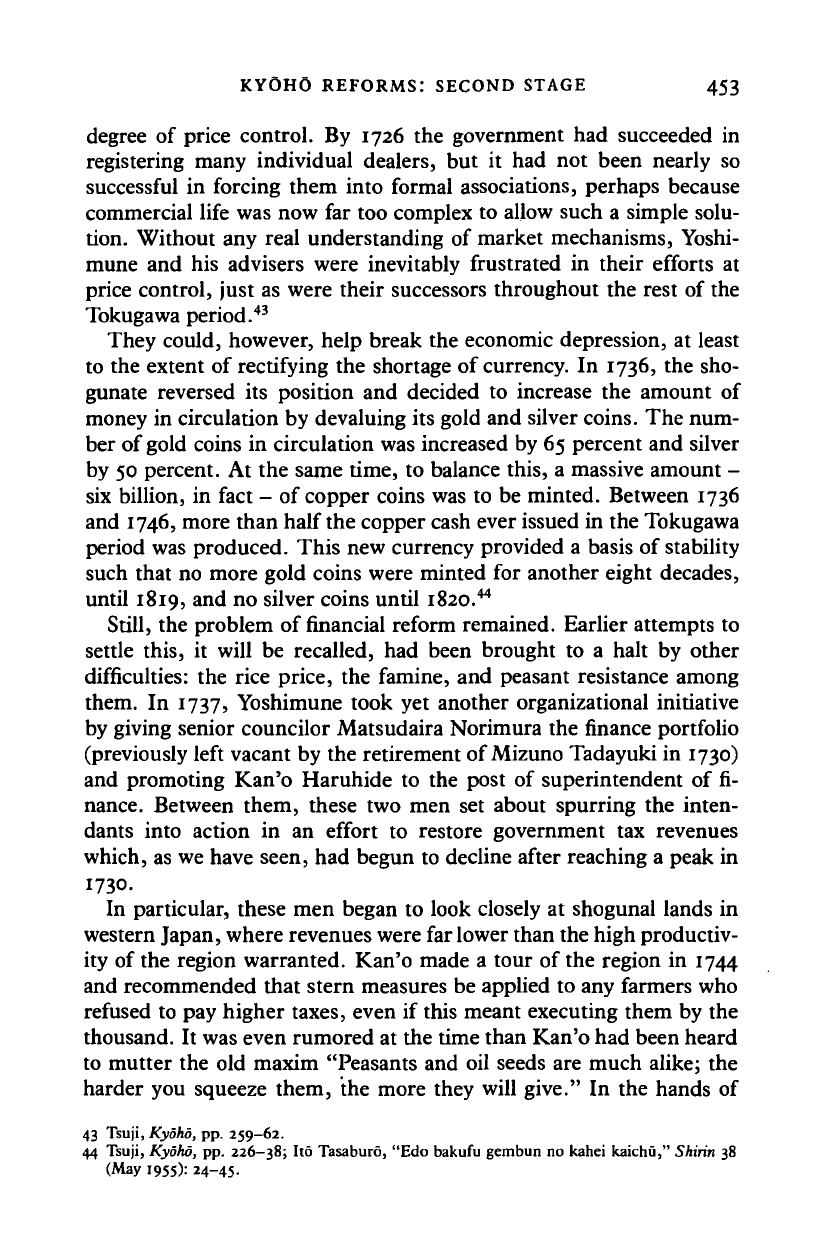
KYOHO REFORMS: SECOND STAGE 453
degree of price control. By 1726 the government had succeeded in
registering many individual dealers, but it had not been nearly so
successful in forcing them into formal associations, perhaps because
commercial life was now far too complex to allow such a simple solu-
tion. Without any real understanding of market mechanisms, Yoshi-
mune and his advisers were inevitably frustrated in their efforts at
price control, just as were their successors throughout the rest of the
Tokugawa period.
43
They could, however, help break the economic depression, at least
to the extent of rectifying the shortage of currency. In 1736, the sho-
gunate reversed its position and decided to increase the amount of
money in circulation by devaluing its gold and silver coins. The num-
ber of gold coins in circulation was increased by 65 percent and silver
by 50 percent. At the same time, to balance this, a massive amount -
six billion, in fact - of copper coins was to be minted. Between 1736
and 1746, more than half the copper cash ever issued in the Tokugawa
period was produced. This new currency provided a basis of stability
such that no more gold coins were minted for another eight decades,
until 1819, and no silver coins until 1820.
44
Still, the problem of financial reform remained. Earlier attempts to
settle this, it will be recalled, had been brought to a halt by other
difficulties: the rice price, the famine, and peasant resistance among
them. In 1737, Yoshimune took yet another organizational initiative
by giving senior councilor Matsudaira Norimura the finance portfolio
(previously left vacant by the retirement of Mizuno Tadayuki in 1730)
and promoting Kan'o Haruhide to the post of superintendent of fi-
nance. Between them, these two men set about spurring the inten-
dants into action in an effort to restore government tax revenues
which, as we have seen, had begun to decline after reaching a peak in
1730.
In particular, these men began to look closely at shogunal lands in
western Japan, where revenues were far lower than the high productiv-
ity of the region warranted. Kan'o made a tour of the region in 1744
and recommended that stern measures be applied to any farmers who
refused to pay higher taxes, even if this meant executing them by the
thousand. It was even rumored at the time than Kan'o had been heard
to mutter the old maxim "Peasants and oil seeds are much alike; the
harder you squeeze them, the more they will give." In the hands of
43 Tsuji, Kyoho, pp. 259-62.
44 Tsuji, Kyoho, pp. 226-38; Ito Tasaburo, "Edo bakufu gembun no kahei kaichu," Shirin 38
(May 1955): 24-45.
Cambridge Histories Online © Cambridge University Press, 2008
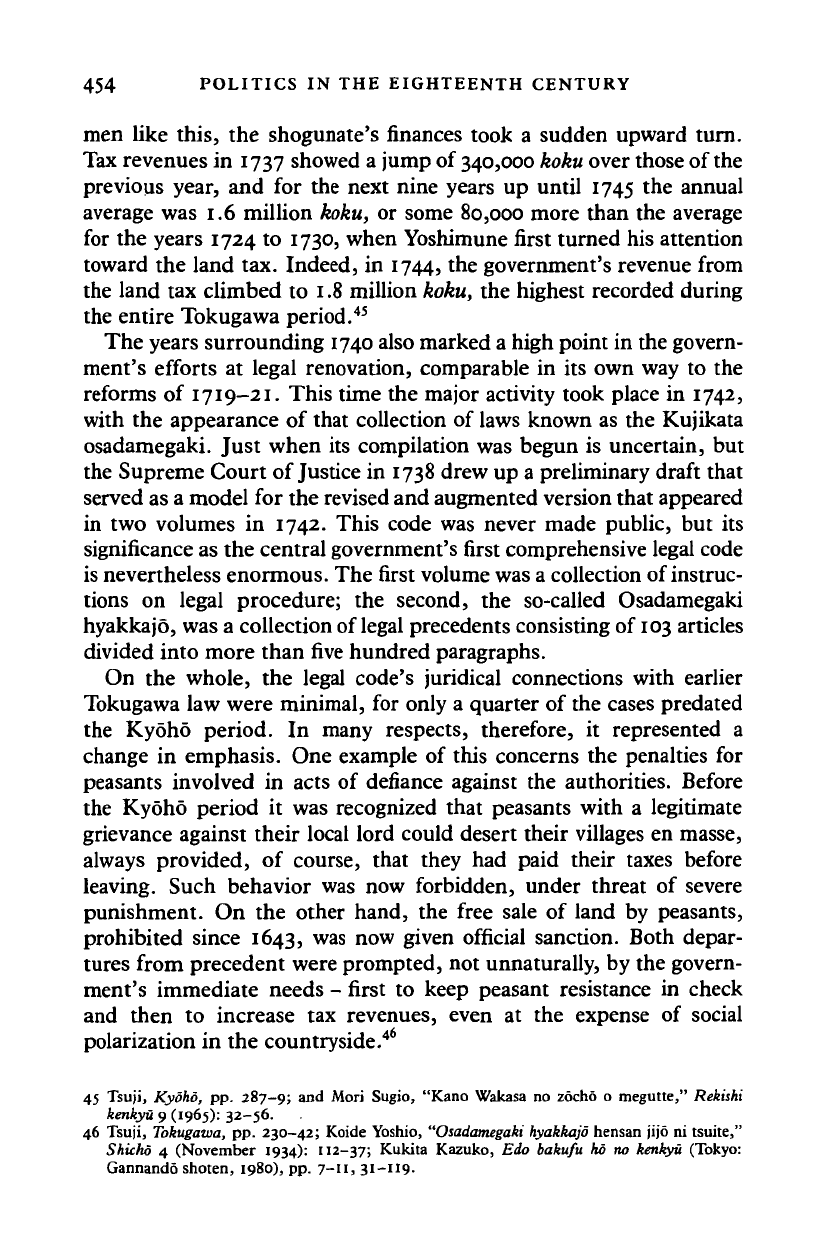
454 POLITICS IN THE EIGHTEENTH CENTURY
men like this, the shogunate's finances took a sudden upward turn.
Tax revenues in 1737 showed a jump of 340,000
koku
over those of the
previous year, and for the next nine years up until 1745 the annual
average was 1.6 million koku, or some 80,000 more than the average
for the years 1724 to 1730, when Yoshimune first turned his attention
toward the land tax. Indeed, in 1744, the government's revenue from
the land tax climbed to 1.8 million koku, the highest recorded during
the entire Tokugawa period.
45
The years surrounding 1740 also marked a high point in the govern-
ment's efforts at legal renovation, comparable in its own way to the
reforms of
1719-21.
This time the major activity took place in 1742,
with the appearance of that collection of laws known as the Kujikata
osadamegaki. Just when its compilation was begun is uncertain, but
the Supreme Court of Justice in 1738 drew up a preliminary draft that
served as a model for the revised and augmented version that appeared
in two volumes in 1742. This code was never made public, but its
significance as the central government's first comprehensive legal code
is nevertheless enormous. The first volume was a collection of instruc-
tions on legal procedure; the second, the so-called Osadamegaki
hyakkajd, was a collection of
legal
precedents consisting of
103
articles
divided into more than five hundred paragraphs.
On the whole, the legal code's juridical connections with earlier
Tokugawa law were minimal, for only a quarter of the cases predated
the Kyoho period. In many respects, therefore, it represented a
change in emphasis. One example of this concerns the penalties for
peasants involved in acts of defiance against the authorities. Before
the Kyoho period it was recognized that peasants with a legitimate
grievance against their local lord could desert their villages en masse,
always provided, of course, that they had paid their taxes before
leaving. Such behavior was now forbidden, under threat of severe
punishment. On the other hand, the free sale of land by peasants,
prohibited since 1643, was now given official sanction. Both depar-
tures from precedent were prompted, not unnaturally, by the govern-
ment's immediate needs - first to keep peasant resistance in check
and then to increase tax revenues, even at the expense of social
polarization in the countryside.
46
45 Tsuji, Kyoho, pp. 287-9; and Mori Sugio, "Kano Wakasa no zocho o megutte," Rekishi
kenkyu
9 (1965): 32-56.
46 Tsuji,
Tokugawa,
pp. 230-42; Koide Yoshio,
"Osadamegaki hyakkajd
hensan jijo ni tsuite,"
Shicho 4 (November 1934): 112-37; Kukita Kazuko, Edo bakufu ho no kenkyu (Tokyo:
Gannando shoten, 1980), pp. 7-11, 31-119.
Cambridge Histories Online © Cambridge University Press, 2008
